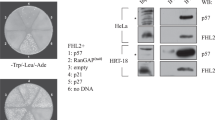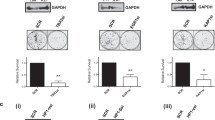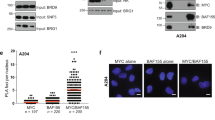Abstract
The BTB/POZ family of proteins has been implicated in multiple biological processes, including tumourigenesis, DNA damage responses and cell cycle progression and development. MIZ-1 (Myc-interacting zinc-finger protein 1) is known to activate transcription of CDKN1A. We recently found that a kidney cancer-related POK transcription factor, KR-POK, is highly expressed in kidney, brain and bone marrow cancer tissues and is a potential proto-oncoprotein. Mouse Kr-pok represses transcription of the CDKN1A by acting on the proximal promoter. The BiFC/FRET assay, co-immunoprecipitation and glutathione S-transferase-fusion protein pull-down assay indicate that MIZ-1 and Kr-pok interact via their POZ domains. Oligoucleotide pull-down assays and chromatin immunoprecipitation assays revealed that MIZ-1 binds to the proximal GC-box#3 (bp, −55 to −63) and the MIZ-1-binding elements, MRE-A (bp, −90 to −64) and MRE-B (bp, −27 to −17). Interestingly, MIZ-1 also binds to the distal p53-binding elements. Kr-pok binds to the proximal GC-box#1 (bp, −95 to −100) and #3 (bp, −55 to −63) relatively strongly. It also shows weak binding to the MREs and the distal p53-binding elements. Kr-pok competes with MIZ-1 in binding to these elements and represses transcription by inhibiting MIZ-1/p300 recruitment, which decreases the acetylation of histones H3 and H4. Our data indicate that Kr-pok stimulates cell proliferation by interfering with the function of MIZ-1 in CDKN1A gene transcription using a mechanism that is radically different from other MIZ-1-interacting proteins, such as B-cell lymphoma 6, c-Myc and Gfi-1.
This is a preview of subscription content, access via your institution
Access options
Subscribe to this journal
Receive 50 print issues and online access
$259.00 per year
only $5.18 per issue
Buy this article
- Purchase on Springer Link
- Instant access to full article PDF
Prices may be subject to local taxes which are calculated during checkout










Similar content being viewed by others
References
Albagli O, Dhordain P, Deweindt C, Lecocq G, Leprince D . (1995). The BTB/POZ domain: a new protein-protein interaction motif common to DNA- and actin-binding proteins. Cell Growth Differ 6: 1193–1198.
Aravind L, Koonin EV . (1999). Fold prediction and evolutionary analysis of the POZ domain: structural and evolutionary relationship with the potassium channel tetramerization domain. J Mol Biol 285: 1353–1361.
Bardwell VJ, Treisman R . (1994). The POZ domain: a conserved protein-protein interaction motif. Genes Dev 8: 1664–1677.
Barna M, Hawe N, Niswander L, Pandolfi PP . (2000). Plzf regulates limb and axial skeletal patterning. Nat Genet 25: 166–172.
Basu S, Liu Q, Qiu Y, Dong F . (2009). Gfi-1 represses CDKN2B encoding p15INK4B through interaction with Miz-1. Proc Natl Acad Sci USA 106: 1433–1438.
Chang CC, Ye BH, Chaganti RS, Dalla-Favera R . (1996). BCL-6, a POZ/zinc-finger protein, is a sequence-specific transcriptional repressor. Proc Natl Acad Sci USA 93: 6947–6952.
Chen Z, Brand NJ, Chen A, Chen SJ, Tong JH, Wang ZY et al. (1993). Fusion between a novel krûppel-like zinc finger gene and the retinoic acid receptor-α locus due to a vatiant t(11;17) translocation associated with acute promyelocytic leukaemia. EMBO J 12: 1161–1167.
Choi WI, Jeon BN, Park H, Yoo JY, Kim YS, Koh DI et al. (2008). Proto-oncogene FBI-1 (Pokemon) and SREBP-1 synergistically activate transcription of fatty-acid synthase gene (FASN). J Biol Chem 283: 29341–29354.
Choi WI, Jeon BN, Yun CO, Kim PH, Kim SE, Choi KY et al. (2009). Proto-oncogene FBI-1 represses transcription of p21CIP1 by inhibition of transcription activation by p53 and Sp1. J Biol Chem 284: 12633–12644.
Costoya JA, Hobbs RM, Barna M, Cattoretti G, Manova K, Sukhwani M et al. (2004). Essential role of Plzf in maintenance of spermatogonial stem cells. Nat Genet 36: 653–659.
Deltour S, Guerardel C, Leprince D . (1999). Recruitment of SMRT/N-CoR-mSin3A-HDAC-repressing complexes is not a general mechanism for BTB/POZ transcriptional repressors: the case of HIC-1 and γFBP-B. Proc Natl Acad Sci USA 96: 14831–14836.
Dhordain P, Albagli O, Lin R J, Ansieau S, Quief S, Leutz A et al. (1997). Corepressor SMRT binds the BTB/POZ repressing domain of the LAZ3/BCL6 oncoprotein. Proc Natl Acad Sci USA 94: 10762–10767.
Dong S, Zhu J, Reid A, Strutt P, Guidez F, Zhong HJ et al. (1996). Amino-terminal protein-protein interaction motif (POZ-domain) is responsible for activities of the promyelocytic leukemia zinc finger-retinoic acid receptor-α fusion protein. Proc Natl Acad Sci USA 93: 3624–3629.
el-Deiry WS, Harper JW, O′Connor PM, Velculescu VE, Canman CE, Jackman J et al. (1994). WAF1/CIP1 is induced in p53-mediated G1 arrest and apoptosis. Cancer Res 54: 1169–1174.
el-Deiry WS, Tokino T, Velculescu VE, Levy DB, Parsons R, Trent JM et al. (1993). WAF1, a potential mediator of p53 tumor suppression. Cell 75: 817–825.
Farkas G, Gausz J, Galloni M, Reuter G, Gyurkovics H, Karch et al. (1994). The Trithorax-like gene encodes the drosophila GAGA factor. Nature 371: 806–808.
Gartel AL . (2009). p21 WAF1/CIP1 and cancer: a shifting paradigm? Biofactors 35: 161–164.
Gartel AL, Radhakrishnan SK . (2005). Lost in transcription: p21 repression, mechanisms, and consequences. Cancer Res 65: 3980–3985.
He X, Park K, Kappes DJ . (2010). The role of ThPOK in control of CD4/CD8 lineage commitment. Annu Rev Immunol 28: 295–320.
Huynh KD, Fischle W, Verdin E, Bardwell VJ . (2000). BCoR, a novel corepressor involved in BCL-6 repression. Genes Dev 14: 1810–1823.
Issa JP, Zehnbauer BA, Kaufmann SH, Biel MA, Baylin SB . (1997). HIC1 hypermethylation is a late event in hematopoieic neoplasms. Cancer Res 57: 1678–1681.
Jeon BN, Choi WI, Yu MY, Yoon AR, Kim MH, Yun CO et al. (2009). ZBTB2, a novel master regulator of the p53 pathway. J Biol Chem 284: 17935–17946.
Jeon BN, Yoo JY, Choi WI, Lee C E, Yoon H G, Hur MW . (2008). Proto-oncogene FBI-1 (Pokemon/Zbtb7A) represses transcription of the tumor suppressor Rb gene via binding competition with Sp1 and recruitment of co-repressors. J Biol Chem 283: 33199–33210.
Kerckaert JP, Deweindt C, Tilly H, Quief S, Lecocq G, Bastard C . (1993). LAZ3, a novel zinc-finger encoding gene, is disrupted by recurring chromosome 3q27 translocations in human lymphomas. Nat Genet 5: 66–70.
Kim MH, Roh HE, Lee MN, Hur MW . (2007). New fast BiFC plasmid assay system for in vivo protein-protein interactions. Cell Physiol Biochem 20: 703–714.
Koh DI, Choi WI, Jeon BN, Lee CE, Yun CO, Hur MW . (2009). A novel POK family transcription factor, ZBTB5, represses transcription of p21CIP1gene. J Biol Chem 284: 19856–19866.
Koonin EV, Senkevich TG, Chernos VI . (1992). A family of DNA virus genes that consists of fused portions of unrelated cellular genes. Trends Biochem Sci 17: 213–214.
Koutsodontis G, Tentes I, Papakosta P, Moustakas A, Kardassis D . (2001). Sp1 plays a critical role in the transcriptional activation of the human cyclin-dependent kinase Inhibitor p21WAF1/Cip1 gene by the p53 tumor suppressor protein. J Biol Chem 276: 29116–29125.
Lee J, Kotliarova S, Kotliarov Y, Li A, Su Q, Donin NM et al. (2006). Tumor stem cells derived from glioblastomas cultured in bFGF and EGF more closely mirror the phenotype and genotype of primary tumors than do serum-cultured cell lines. Cancer Cell 9: 391–403.
Liu Q, Basu S, Qiu Y, Tang F, Dong F . (2010). A role of Miz-1 in Gfi-1-mediated transcriptional repression of CDKN1A. Oncogene 29: 2843–2852.
Lin RJ, Nagy L, Inoue S, Shao W, Miller Jr WH, Evans RM . (1998). Role of the histone deacetylase complex in acute promyelocytic leukaemia. Nature 391: 811–814.
Maeda T, Hobbs RM, Merghoub T, Guernah I, Zelent A, Cordon-Cardo C et al. (2005). Role of the proto-oncogene Pokemon in cellular transformation and ARF repression. Nature 433: 278–285.
Ogryzko VV, Schiltz RL, Russanova V, Howard BH, Nakatani Y . (1996). The transcriptional coactivators p300 and CBP are histone acetyltransferases. Cell 87: 953–959.
Ogryzko VV, Wong P, Howard BH . (1997). WAF1 retards S-phase progression primarily by inhibition of Cyclin-dependent kinases. Mol Cell Biol 17: 4877–4882.
Peukert K, Staller P, Schneider A, Carmichael G, Hänel F, Eilers M . (1997). An alternative pathway for gene regulation by Myc. EMBO J 16: 5672–5686.
Phan RT, Saito M, Basso K, Niu H, Dalla-Favera R . (2005). BCL6 interacts with the transcription factor Miz-1 to suppress the cyclin-dependent kinase inhibitor p21 and cell cycle arrest in germinal center B cells. Nat Immunol 10: 1054–1060.
Piluso D, Bilan P, Capone JP . (2002). Host cell factor-1 interacts with and antagonizes transactivation by the cell cycle regulatory factor Miz-1. J Biol Chem 277: 46799–46808.
Seoane J, Le H, Massague J . (2002). Myc suppression of the p21Cip1 cdk inhibitor influences the outcome of the p53 response to DNA damage. Nature 419: 729–734.
Sun L, Hui AM, Su Q, Vortmeyer A, Kotliarov Y, Pastorino S et al. (2006). Neuronal and glioma-derived stem cell factor induces angiogenesis within the brain. Cancer Cell 9: 287–300.
Toledo F, Wahl GM . (2006). Regulating the p53 pathway: in vitro hypotheses, in vivo veritas. Nat Rev Cancer 6: 909–923.
Weber A, Marquardt J, Elzi D, Forster N, Starke S, Glaum A et al. (2008). Zbtb4 represses transcription of p21CIP1 and controls the cellular response to p53 activation. EMBO J 27: 1563–1574.
Willenbring H, Sharma AD, Vogel A, Lee AY, Rothfuss A, Wang Z et al. (2008). Loss of p21 permits carcinogenesis from chronically damaged liver and kidney epithelial cells despite unchecked apoptosis. Cancer Cell 14: 59–67.
Yamochi T, Kaneita Y, Akiyama T, Mori S, Moriyama M . (1999). Adenovirus-mediated high expression of BCL-6 in CV-1 cells induces apoptotic cell death accompanied by down-regulation of BCL-2 and BCL-XL . Oncogene 18: 487–494.
Zhan F, Barlogie B, Arzoumanian V, Huang Y, Williams DR, Hollmig K et al. (2007). Gene-expression signature of benign monoclonal gammopathy evident in multiple myeloma is linked to good prognosis. Blood 109: 1692–1700.
Acknowledgements
This work was mainly funded by a Basic Science Research Grant (314-2008-1-E00030 to M-W Hur and C-E Lee), and MRC (R13-2002-054-05002-0) from the National Research Foundation of Korea, and also by a Faculty Research Grant from Yonsei University School of Medicine.
Author information
Authors and Affiliations
Corresponding author
Ethics declarations
Competing interests
The authors declare no conflict of interest.
Additional information
Supplementary Information accompanies the paper on the Oncogene website
Supplementary information
Rights and permissions
About this article
Cite this article
Lee, K., Choi, W., Koh, D. et al. The proto-oncoprotein KR-POK represses transcriptional activation of CDKN1A by MIZ-1 through competitive binding. Oncogene 31, 1442–1458 (2012). https://doi.org/10.1038/onc.2011.331
Received:
Revised:
Accepted:
Published:
Issue Date:
DOI: https://doi.org/10.1038/onc.2011.331
Keywords
This article is cited by
-
Proto-oncoprotein Zbtb7c and SIRT1 repression: implications in high-fat diet-induced and age-dependent obesity
Experimental & Molecular Medicine (2021)
-
NMR structure note: solution structure of human Miz-1 zinc fingers 8 to 10
Journal of Biomolecular NMR (2012)



